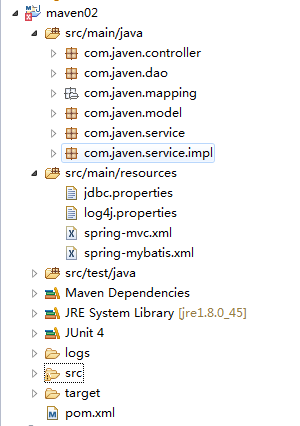Java使用OpenFeign管理多個第三方服務調用
最近開發了一個統一調度類的項目,需要依賴多個第三方服務,這些服務都提供了HTTP接口供我調用。

組件架構
服務多、接口多,如何進行第三方服務管理和調用就成了問題。
常用的服務間調用往往采用zk、Eureka等注冊中心進行服務管理(SpringBoot常使用SpringCloud)。OpenFeign也是SpringCloud的解決方案之一。我們單獨使用OpenFeign, 無需對原有第三方服務進行改動,本服務開發時的引入也很輕量。
下面給出我的用法。
應用maven依賴引入maven依賴:
<dependency> <groupId>io.github.openfeign</groupId> <artifactId>feign-core</artifactId> <version>10.2.3</version> </dependency> <dependency> <groupId>io.github.openfeign</groupId> <artifactId>feign-gson</artifactId> <version>10.2.3</version> </dependency> <dependency> <groupId>io.github.openfeign.form</groupId> <artifactId>feign-form</artifactId> <version>3.8.0</version> </dependency> <dependency> <groupId>io.github.openfeign.form</groupId> <artifactId>feign-form-spring</artifactId> <version>3.8.0</version> </dependency>
其中,form相關引入是為了解決ContentType為application/x-www-form-urlencoded和multipart/form-data的編碼問題。
配置和服務聲明第三方服務的地址通過配置來注入。
服務地址配置ThirdpartServiceConfig.java
@Data@Component@ConfigurationProperties(prefix = 'thirdpart-service')public class ThirdpartServiceConfig { private String serviceA; private String serviceB; private String serviceC;}
服務配置(超時時間配置等也可以寫在這里) application.yaml
thirdpart-service: serviceA: http://****:***/ serviceB: http://****:***/ serviceC: http://****:***/第三方服務配置
因為聲明方法一致,所以省略了多個第三方聲明。 ThirdPartClientConfig.java
@Configurationpublic class ThirdParttClientConfig { @Resource private ThirdpartServiceConfig thirdpartServiceConfig; @Bean public ServiceAClient serviceAClient() {return Feign.builder() .encoder(new FormEncoder(new GsonEncoder())) .decoder(new GsonDecoder()) .target(ServiceAClient.class, thirdpartServiceConfig.getServiceA()); }}接口聲明和使用
完成了服務的聲明和服務的配置之后,就可以進行服務接口的聲明了。具體聲明方法可以參看OpenFeign文檔:# 翻譯: Spring Cloud Feign使用文檔
下面給出使用示例:
GET請求(feign可直接將返回的結果反序列化為本服務中定義的POJO)
@RequestLine('GET testGet?a={a}&b={b}')ServiceResp testGet(@Param('a') String a,@Param('b')String b);
GET 下載使用feign.Response接收請求結果
@RequestLine('GET export?exportId={exportId}')Response exportFromServiceA(@Param('exportId')String exportId);
@Resourceprivate ServiceAClient serviceAClient ;// 導出方法public void export(exportId) { Response serviceResponse = serviceserviceAClient.exportFromServiceA(exportId); Response.Body body = serviceResponse.body(); try(InputStream inputStream = body.asInputStream();// 處理獲取到的inputStream } catch (IOException e) { log.error('導出發生異常',e);}
POST application/json'
@RequestLine('POST /save') @Headers('Cofntent-Type: application/json') ServiceResp saveEntity(EntityPOJO entityPOJO);
POST form
@RequestLine('POST uqa/repo/qa/batch') @Headers('Content-Type:multipart/form-data') ServiceResp uploadFile(@Param('id')String id, @Param('batch_file') File file); 注意:除了file類型,其他參數會被序列化為String,所以若第三方接口參數的值為POJO(或Map),可能會出錯。 對于POJO參數,若第三方參數名含有Java中不合法的屬性字符(如 ”-“,”#“,”.“等),可使用注解進行序列化時的轉化。由于聲明Feign Client時使用的encoder是Gson,所以使用如下注解:
@SerializedName(value='aaa-bbb') private String aaaBbb;
如果使用的是其他序列化工具,改為對應的注解即可。
小結使用聲明式的第三方和接口寫法,基本覆蓋了請求第三方接口的需求,也易于拓展和管理。
我計劃在后續添加統一的鑒權、日志打印和異常捕獲處理功能,使依賴組件引入的風險更為可控。OpenFeign幫我們實現了服務聲明、接口聲明、HTTP請求發送和結果處理等邏輯,在項目需要調用多個第三方服務時可以使用。
到此這篇關于Java使用OpenFeign管理多個第三方服務調用的文章就介紹到這了,更多相關Java 第三方服務調用內容請搜索好吧啦網以前的文章或繼續瀏覽下面的相關文章希望大家以后多多支持好吧啦網!
相關文章:

 網公網安備
網公網安備